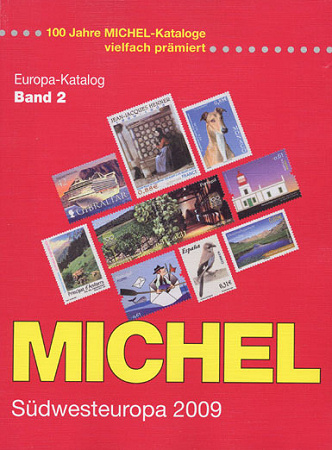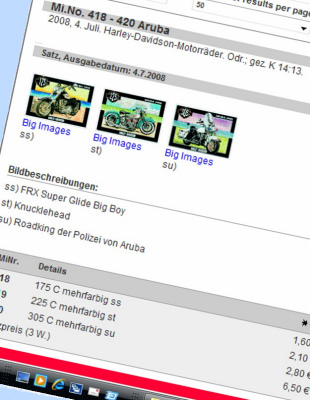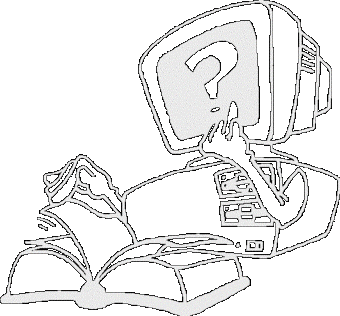Michel, a world catalog
Spread over the world there is a large number of stamp catalogs available. National associations often make their own catalog, like the NVPH in our country, and our southern neighbors in the OBP (Official Belgian Stamp Catalog), or in France the Ceres. Global catalogs like Bolaffi, the Chinese Yang and the Swiss Zumstein are widely used in the countries of their publishers, but there are only four leading "heavyweights". For the American region it is the Scott catalog, and in the Commonwealth areas it will be the Stanley Gibbons. French speaking countries mainly use the Yvert & Tellier, but in general the Michel catalog surely is nowadays used mostly over the whole world.
As early as in 1861, Oscar Berger-Levrault published a list in which the stamp issues of all countries were mentioned. The Frenchman Potiquet took this list as a basis for his already illustrated sales list. Englishman Edward Gray is listed in the books as the first editor of a stamp catalog. In 1865 the first list by Gibbons appeared. In 1896 Theodore Champion published the first Yvert (publisher) catalog. On the other side of the great ocean it was John Walter Scott who compiled a useful list.
In the German town Apolda Georg Hugo Paul Michel, son of a beer carrier, was born on April 4th 1866. Already at young age he was afflicted with the stamp virus and on his travels through Europe he collected a lot of stamps. For extra earnings he started trading stamps, and sold mainly packets with stamps to stores in school supplies.

Hugo Michel depicted on a stamp of Antigua & Barbuda from 1993,
copied from the Michel On-Line site
Together with his brother he started a stamp shop, and in 1898 he started co-operation with the then leading catalog publisher Senf. Suffering from various personal setbacks he partly withdraw from the shop, but decided to maintain his work on the price list. This resulted in the first Michel catalog in 1909, 100 years ago.
In those first years Michel published an annual catalog Europe. In 1912 Hugo started with an update on the catalog four times a year. In fact this was the first Michel Rundschau, the contemporary periodical magazine of new stamp issues from Michel. In the following years more updated catalogs of Hugo's hand appeared, and in 1920 the first "Overseas" volume was issued.
In 1924 the publishing of the catalog was transferred to Schwanenberg Verlag, which already was a stock book and album manufacturer, and with this the rights of the Michel catalog came in the hands of owner Eugen Berlin. After the Second World War the publisher moved from Weimar to Leipzig and the series was extended with special Michel catalogs, such as a catalog Ganzsachen (stationary) of Germany, a CEPT / UNO part, a philatelic letter catalog and many other text books and compilations.
Today the total Michel catalogue comprises Europe in 7 volumes, one volume for America, a volume for the Caribbean and a volume for South America. Africa and Asia each count three volumes and Australia makes the last part. In total the world catalog consists of 17 volumes. Each volume costs around 45 euro, making it an expensive collection. Apart from this Michel also has a number of special volumes of German territories.

For computer freaks Michel summarized all these parts in an On-Line catalog for a low price of 5.90 euro per Month. At www.briefmarken.de you can check for free whether this is useful for you. Below a print of a webpage, coincidentally about a motorcycle issue:

Especially in Europe, but also increasingly global, the Michel catalog is used by the traders and collector. The price quotations are often leading and the completeness is excellent. In the years of the emergence of Bogus issues Michel was very reserved to include the not (yet) officially identified issues, and even now, only those issues by the UPU (WADP) recognized are in the books. Of course mistakes are sometimes made, but they are corrected later. In this way it can happen that the numbering of a country sometimes shows a gap of a few numbers.
 We also use the Michel catalog as a guideline to compile the MFN catalog and I must say that also we have some reservations. But along with the Michel site, WADP for us still remains the most useful and trusted medium for determining whether or not a stamp should be in the MFN catalog. We also use the Michel catalog as a guideline to compile the MFN catalog and I must say that also we have some reservations. But along with the Michel site, WADP for us still remains the most useful and trusted medium for determining whether or not a stamp should be in the MFN catalog.
Hans de Kloet
Top - Back to former page - Home |



 We also use the Michel catalog as a guideline to compile the MFN catalog and I must say that also we have some reservations. But along with the Michel site, WADP for us still remains the most useful and trusted medium for determining whether or not a stamp should be in the MFN catalog.
We also use the Michel catalog as a guideline to compile the MFN catalog and I must say that also we have some reservations. But along with the Michel site, WADP for us still remains the most useful and trusted medium for determining whether or not a stamp should be in the MFN catalog.